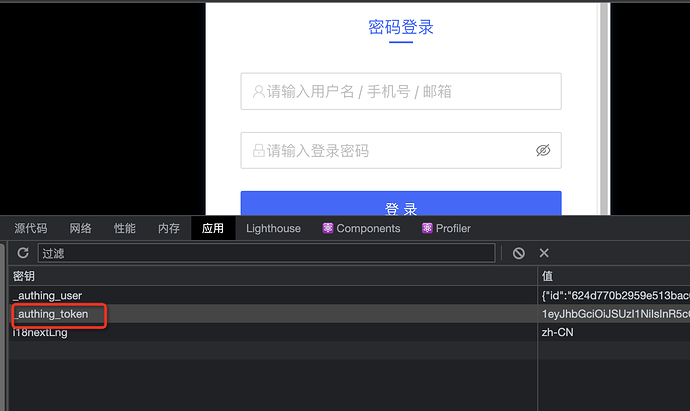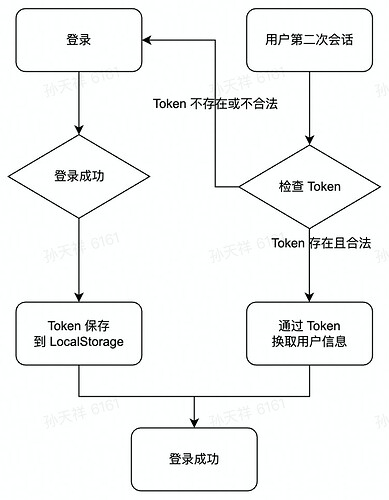备注:删除这token,登陆流程就没问题了
咱们现在使用的 Guard 版本是什么~,使用的登录方式是什么呢~
我现在按照截图来看 咱们使用的是 AuthingGuard 这个组件吧~ 目前我们 一直在迭代更新的是 Guard 组件,并且 Guard 组件已经废弃主动将 token、user 写到 LocalStorage 中,看一下咱们的组件可以进行替换吗?如果不行的话 遇到的问题可以继续反馈~
方便发一下 目前项目中这部分的代码吗?我现在只能判断是 咱们的引用有些问题~ 如果有完整的示例代码我这里更好判断一些~
登陆页面代码
import React from 'react';
import { history, useModel } from 'umi';
import styles from './index.less';
import SelectDomain from '@/components/SelectDomain';
// import useRequest from '@ahooksjs/use-request';
import { AuthingGuard } from '@authing/react-ui-components';
// 引入 css 文件
import '@authing/react-ui-components/lib/index.min.css';
const Login: React.FC = () => {
const { initialState, setInitialState } = useModel('@@initialState');
const fetchUserInfo = async () => {
const userInfo = await initialState?.fetchUserInfo?.();
if (userInfo) {
await setInitialState((s) => ({
...s,
currentUser: userInfo,
}));
}
};
return (
<div className={styles.container}>
<div className={styles.lang} data-lang>
<div style={{ display: 'block', float: 'right' }}>
<SelectDomain />
</div>
</div>
<AuthingGuard
appId="xxxxx"
onLogin={async (userinfo) => {
// console.log(userinfo);
await fetchUserInfo();
/** 此方法会跳转到 redirect 参数所在的位置 */
if (!history) return;
const { query } = history.location;
const { redirect } = query as { redirect: string };
history.push(redirect || '/');
}}
/>
</div>
);
};
export default Login;
登陆成功后读取用户信息。fetchUserInfo
import type { Settings as LayoutSettings } from '@ant-design/pro-layout';
import type { RunTimeLayoutConfig, RequestConfig } from 'umi';
import { history, Link } from 'umi';
import RightContent from '@/components/RightContent';
import { BookOutlined, LinkOutlined } from '@ant-design/icons';
import { debug as createDebug } from 'debug';
import { initAuthClient, useAuthing } from '@authing/react-ui-components';
initAuthClient({
appId: 'xxxxx',
});
const { authClient } = useAuthing();
globalThis.d = createDebug('debug');
// global.debug = d('default');
const isDev = process.env.NODE_ENV === 'development';
const loginPath = '/user/login';
let token: Maybe<string> | undefined;
/** 获取用户信息比较慢的时候会展示一个 loading */
export const initialStateConfig = {
// loading: <Spin />,
};
/**
* @see https://umijs.org/zh-CN/plugins/plugin-initial-state
* */
export async function getInitialState(): Promise<{
settings?: Partial<LayoutSettings>;
currentUser?: API.CurrentUser;
fetchUserInfo?: () => Promise<API.CurrentUser | undefined>;
}> {
const fetchUserInfo = async () => {
let r = await authClient?.getCurrentUser();
// debugger
if (r) {
token = r.token;
return {
name: r.username,
avatar: r.photo,
} as API.CurrentUser;
}
return undefined;
};
// 如果是登录页面,不执行
if (history.location.pathname !== loginPath) {
const currentUser = await fetchUserInfo();
return {
fetchUserInfo,
currentUser,
settings: {},
};
}
return {
fetchUserInfo,
settings: {},
};
}
// ProLayout 支持的api https://procomponents.ant.design/components/layout
export const layout: RunTimeLayoutConfig = ({ initialState }) => {
return {
rightContentRender: () => <RightContent />,
disableContentMargin: false,
// waterMarkProps: {
// content: initialState?.currentUser?.name,
// },
// footerRender: () => <Footer />,
onPageChange: () => {
const { location } = history;
// 如果没有登录,重定向到 login
if (!initialState?.currentUser && location.pathname !== loginPath) {
history.push(loginPath);
}
},
links: isDev
? [
<Link to="/umi/plugin/openapi" target="_blank">
<LinkOutlined />
<span>OpenAPI 文档</span>
</Link>,
<Link to="/~docs">
<BookOutlined />
<span>业务组件文档</span>
</Link>,
]
: [],
menuHeaderRender: undefined,
// 自定义 403 页面
// unAccessible: <div>unAccessible</div>,
...initialState?.settings,
};
};
export const request: RequestConfig = {
errorConfig: {
adaptor: (resData) => {
// debugger
return {
...resData,
success: resData.success,
errorMessage: resData.message,
showType: 4,
};
},
},
credentials: 'include',
requestInterceptors: [
(url, options) => {
const requestDomain = localStorage.getItem('requestDomain') || '';
let u = url;
let h = options.headers as HeadersInit;
h['Authorization'] = `Bearer ${token}`;
if (!u.startsWith('http')) {
if (requestDomain) {
u = requestDomain + url;
}
}
return {
// 修改请求路径
url: u,
options: {
...options,
},
};
},
],
};
其实问题很简单。就是我看network的时候,登陆请求,是已经显示登陆成功了。
然后在获取用户信息,返回了当前状态是未登陆,看了下network的cookie,授权的token是老的,没有用到登陆成功后的token。所以说到底就是token的本地缓存没更新成功。下面我提供下截图,我把本地token改成一个错误的,前面加了个“1”。如果有其他的sdk包,可以提供下,我这边切换也方便
主要是咱们的使用方式有些问题,拆分为三个问题
- 老版本 Guard 替换成新版本 Guard
新版本中的 Guard 组件已经废弃主动将 token、user 写到 LocalStorage 中,需要使用者手动进行维护。
import { AuthingGuard } from '@authing/react-ui-components';
将这部分引用替换为 Guard 即可,Props 传值的方式不用变化
import { Guard } from '@authing/react-ui-components';
-
AuthClient 的使用
代码中咱们直接使用的是 initAuthClient,按照您提供的业务场景中并不推荐这样使用,如果想使用 AuthClient 可以直接初始化 SDK,或者可以使用 onLogin 回调返回的 AuthClient。直接使用 useAuthing + initAuthClient 的话回导致 SDK 内部状态不一致,导致一些不可控的错误。 -
Token 有效性校验问题
在获取当前用户时,应该优先判断 Token 是否被篡改,检查的方法为 checkLoginStatus 以及 Token 相关文档
我还有个疑问。你这里说新的Guard,不再维护本地token,那么是不是说,用户每次打开页面,登陆状态都会被重置,需要重新登陆才能后续操作了。AuthClient需要通过onLogin来获取。
- 在 onLogin 的回调中会返回 user 对象,user 对象中有 Token 属性,咱们可以手动保存在 LocalStorage 中或者其他的地方,不用再依赖 Guard 的保存了
- 在 onLogin 中获取 AuthClient 只是其中的一个方法,咱们可以直接使用 SDK 初始化 AuthClient。
- 通过 Token 可以获取到用户的详情信息的,我们的 SDK 中提供了方法 getCurrentUser,具体的使用方式可以看一下这个方法的文档。
我简单的画了一下 业务流程图 可以参考一下



